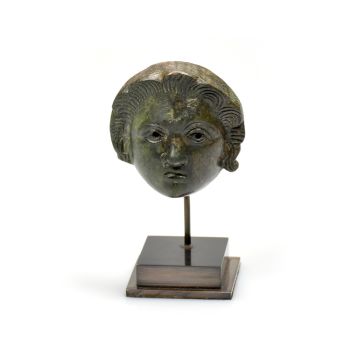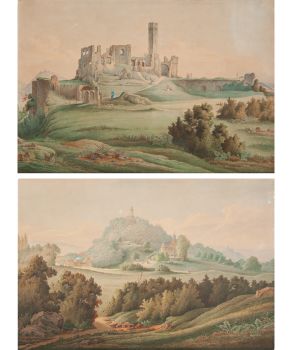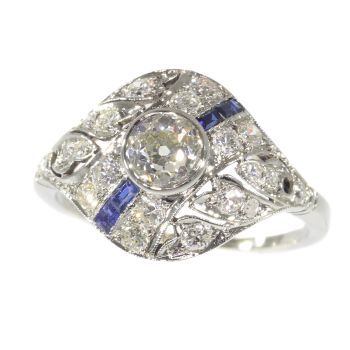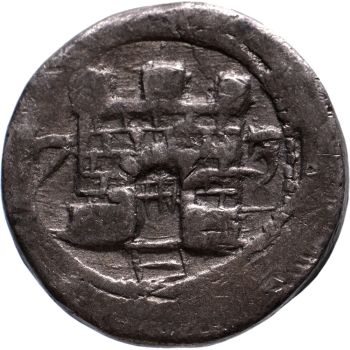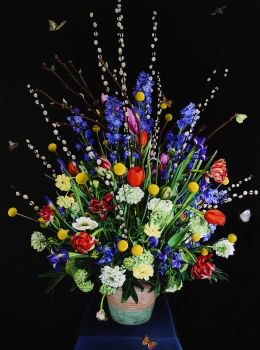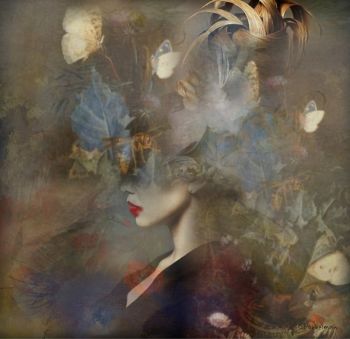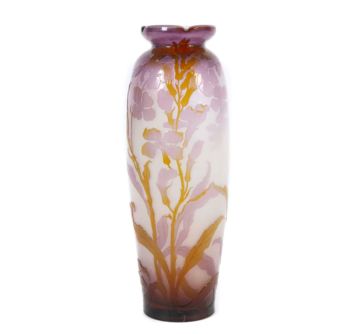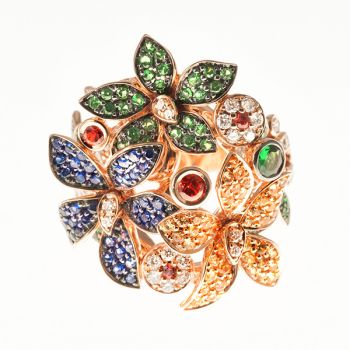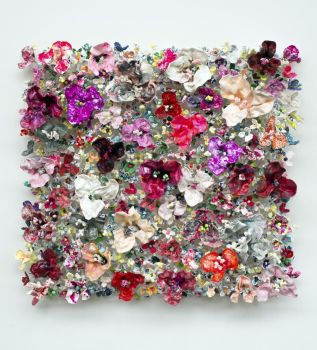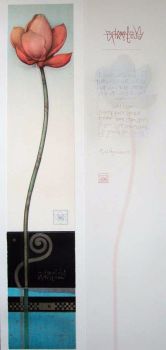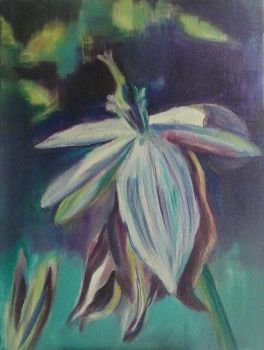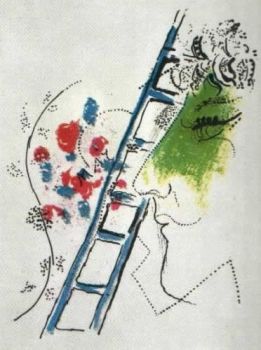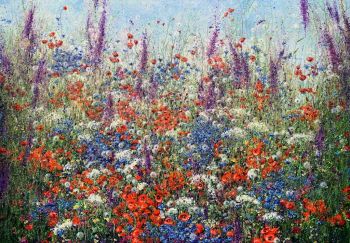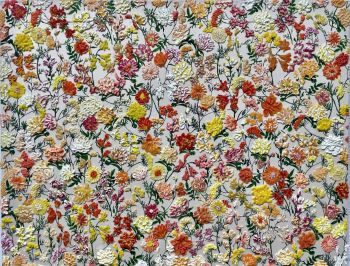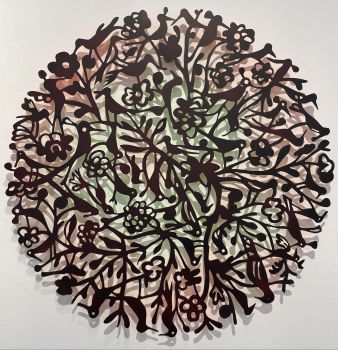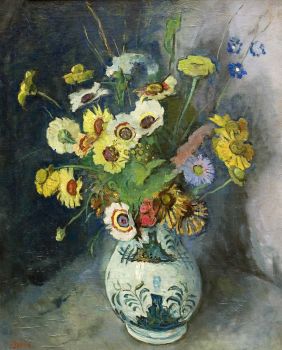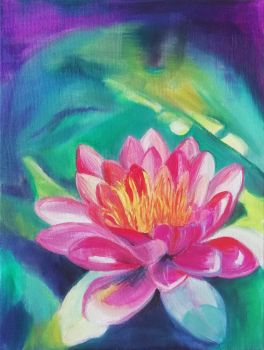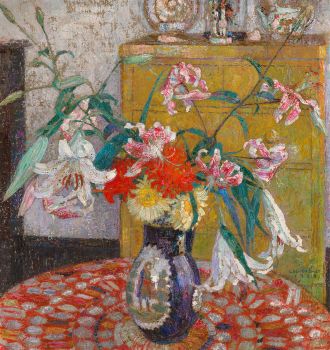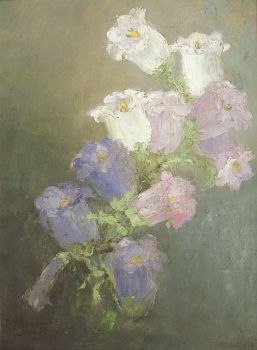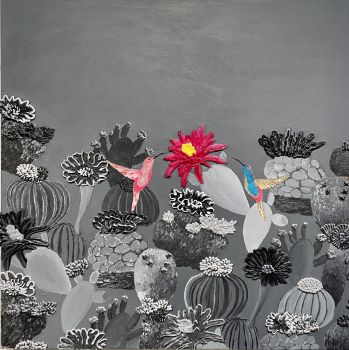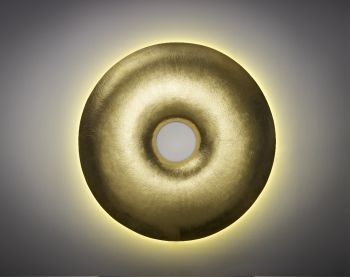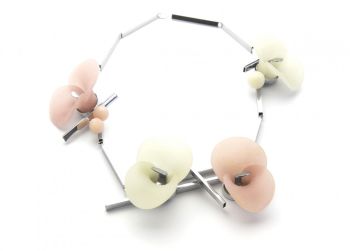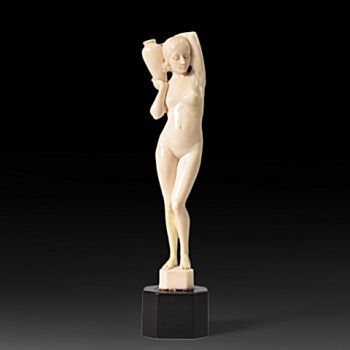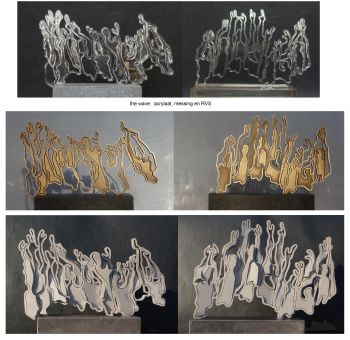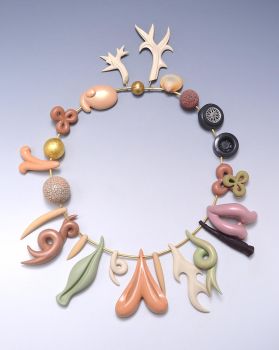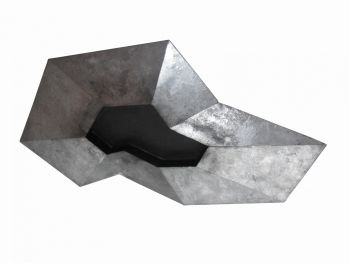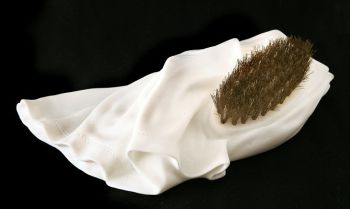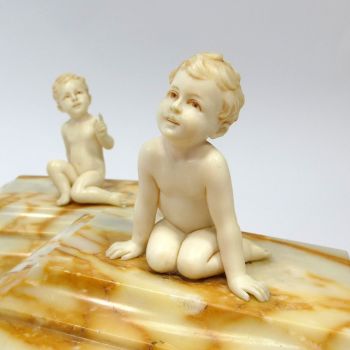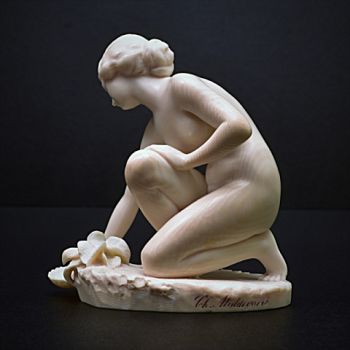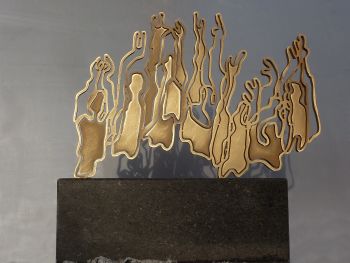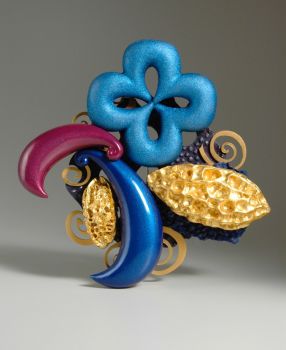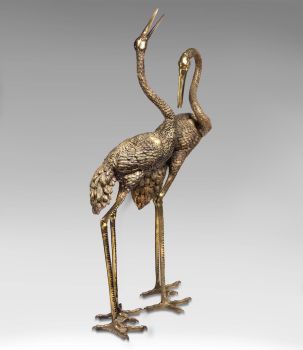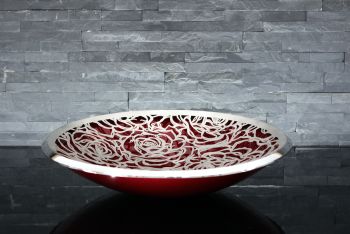Indian colonial inlaid work box, 18th century 1700 - 1750
Artista Sconosciuto
ossoLegnaAvorioMetalloOttone
33 ⨯ 48 ⨯ 12 cm
ConditionGood
€ 3.500
Verkoulen Oriental & European Antiques
- A proposito di opere d'arteAn exotic (Anglo-)Indian work box made of rosewood and ebony with ivory inlaid floral motifs, 18th century, around 1700-1750, Vizagapatam, India.
Dimensions: 32,5 x 47,5 x 12 cm.
This larger document or work box is an example of typical early 18th century craftmanship influenced by the Europeans but also the Indian taste and culture. The brownish with darker veining rosewood is considered as a precious hardwood and perfect to withstand the warm and moistures climate of the Indian ocean region and Indonesian archipelago. The ivory is etched and filled with black lacquer to form a shade on the flower buds. The ‘scrolling vines’ created out of black leaves and stems of the flower are inlaid with ebony wood. The top lid had four studded floral rosettes, and the sides of the box have brass handles. The front is also provided with an elegant brass lock plate and a key. On the inside we can find several compartments to store writing materials.
Vizagapatam was a fundamental center for production of luxurious objects exported to Europe and other ports. It was a part of Madras Presidency (the administrative divisions of Madras, province of British India with St. George fort) from the 17th century till the independence in 1947. The first written reference to ivory inlayed furniture in Vizagapatam was made in 1756 by Major John Corneille, who noted that the area was known for the quality of its Chintz (processed fabric), which is “esteemed the best in India for the brightness of its colours”, and that "the place is likewise remarkable for its inlay work, and justly for they do it to the greatest perfection". The British East India Company had a textile factory in Vizagapatam from 1668. Eventually by 1768 the British gained control over the whole area. It was a tradition in Vizagapatam to manufacture furniture in Western style, using ivory etched with lacquer inlaid into wood. The decoration they used in Vizagapatam was inspired from the Mughal culture. Even though the British had control over Vizagapatam and other regions, objects produced in Vizagapatam during the 18th century were also made for company officials from Holland as wel as the European market.
Condition: Good, some wear to the inlay work.
For a similar example mounted on a later stand, see: Christie's 17 February 2016, Live auction 12033, lot nr. 267.
NOTE: Please note that the shipping time takes longer for this object, because the need of CITES-Documents for export! - A proposito di opere artista
Può succedere che un artista o un creatore sia sconosciuto.
Alcune opere non sono determinate da chi sono state realizzate o sono state realizzate da (un gruppo di) artigiani. Esempi sono statue dell'antichità, mobili, specchi o firme non chiare o leggibili ma anche alcune opere non sono affatto firmate.
Inoltre puoi trovare la seguente descrizione:
•"Attribuito a …." A loro avviso probabilmente opera dell'artista, almeno in parte
•“Studio di ….” o “Officina di” A loro avviso un'opera eseguita nello studio o nella bottega dell'artista, eventualmente sotto la sua supervisione
•“Cerchio di…” A loro avviso un'opera del periodo dell'artista che mostra la sua influenza, strettamente legata all'artista ma non necessariamente al suo allievo
•"Stile di..." o "Seguace di..." A loro avviso un'opera eseguita nello stile dell'artista ma non necessariamente da un allievo; può essere contemporaneo o quasi contemporaneo
•“Modalità di…” A loro avviso un'opera nello stile dell'artista ma di epoca successiva
•"Dopo …." A loro avviso una copia (di qualsiasi data) di un'opera dell'artista
•“Firmato…”, “Datato…” o “Iscritto” A loro avviso l'opera è stata firmata/datata/inscritta dall'artista. L'aggiunta di un punto interrogativo indica un elemento di dubbio
•"Con firma....", "Con data...", "Con iscrizione..." o “Riporta firma/data/iscrizione” a loro avviso la firma/data/iscrizione è stata aggiunta da qualcuno diverso dall'artista
Sei interessato ad acquistare questa opera d'arte?
Artwork details
Related artworks
- 1 - 4 / 12
Paulus Franciscus Kromjong
Fiori davanti ad Arearea Aka (gioia) di Gauguin'20th century
Prezzo su richiestaZebregs & Röell - Fine Art - Antiques
Artista Sconosciuto
A Surinam-themed Amsterdam long-case clock1746 - 1756
Prezzo su richiestaZebregs & Röell - Fine Art - Antiques
 A cura di
A cura diGallerease Magazine
Hubert Vos
Ritratto di un punjabi nell'India britannica1898
Prezzo su richiestaZebregs & Röell - Fine Art - Antiques
Artista Sconosciuto
UN INSOLITO PIATTO D'ARGENTO LOBBATO INDONESIlate 17th
Prezzo su richiestaZebregs & Röell - Fine Art - Antiques
Thea G.F. Eschauzier
Ritratto di una ragazza giavanese1931
Prezzo su richiestaZebregs & Röell - Fine Art - Antiques
Artista Sconosciuto
A silver spoon commemorating Juff’ Margareta van Hoorn1656 - 1694
Prezzo su richiestaZebregs & Röell - Fine Art - Antiques
Artista Sconosciuto
Japanese transition-style lacquer coffer 1640 - 1650
Prezzo su richiestaZebregs & Röell - Fine Art - Antiques
1 - 4 / 20Artista Sconosciuto
UN MODELLO GIAPPONESE DI UN NORIMONO, UN PALANQUIN1650 - 1700
Prezzo su richiestaZebregs & Röell - Fine Art - Antiques
Artista Sconosciuto
The Stamford Raffles Secretaires.1800 - 1813
Prezzo su richiestaZebregs & Röell - Fine Art - Antiques
Artista Sconosciuto
UN CONTENITORE PER DOCUMENTI DELLO SRI LANKA IN ARGENTO DORATO19th century
Prezzo su richiestaZebregs & Röell - Fine Art - Antiques
Artista Sconosciuto
UN NETSUKE IN AVORIO DI UN OLANDESE CHE TIENE UN GALLETTO18th century
Prezzo su richiestaZebregs & Röell - Fine Art - Antiques
Artista Sconosciuto
UN PICCOLO NETSUKE IN AVORIO DI UN OLANDESE CON UN TAMBURO1750 - 1800
Prezzo su richiestaZebregs & Röell - Fine Art - Antiques
Artista Sconosciuto
UN NETSUKE IN AVORIO DI UN OLANDESE CHE GIOCA CON UN RAGAZZINO18th century
Prezzo su richiestaZebregs & Röell - Fine Art - Antiques
Artista Sconosciuto
UN NETSUKE MARINO IN AVORIO DI UN OLANDESE CHE TIENE UN FAN . CINESE18th century
Prezzo su richiestaZebregs & Röell - Fine Art - Antiques
Artista Sconosciuto
UN RARO SADELI INDIANO COMPLETO DI LAVORO E SCRITTURA INTARSIATI1800 - 1850
Prezzo su richiestaZebregs & Röell - Fine Art - Antiques
Artista Sconosciuto
UN RARO GRANDE TELESCOPIO GIAPPONESE IN PELLE LACCATA1750 - 1800
Prezzo su richiestaZebregs & Röell - Fine Art - Antiques
Artista Sconosciuto
COPPIA DI TORCHÈRE O PORTACANDELE IN TEAK INDONESI LACCATI E DORATI18th century
Prezzo su richiestaZebregs & Röell - Fine Art - Antiques
1 - 4 / 24Frères Daum
Daum Nancy – “Paysage Soleil Couchant” vase with two applied handles1900 - 1910
Prezzo su richiestaAntiques Emporium
1 - 4 / 24Artista Sconosciuto
UN RARO SADELI INDIANO COMPLETO DI LAVORO E SCRITTURA INTARSIATI1800 - 1850
Prezzo su richiestaZebregs & Röell - Fine Art - Antiques
Linda Verkaaik
The Wave 15/20/30 cm - acrylic/ brass/RVS2020
Prezzo su richiestaGalerie Bianca Landgraaf
Artista Sconosciuto
UN PICCOLO NETSUKE IN AVORIO DI UN OLANDESE CON UN TAMBURO1750 - 1800
Prezzo su richiestaZebregs & Röell - Fine Art - Antiques
Artista Sconosciuto
UN NETSUKE MARINO IN AVORIO DI UN OLANDESE CHE TIENE UN FAN . CINESE18th century
Prezzo su richiestaZebregs & Röell - Fine Art - Antiques
1 - 4 / 24- 1 - 4 / 5








